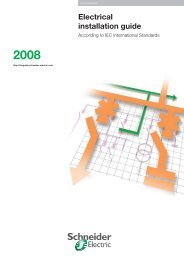MV design guide - Schneider Electric
MV design guide - Schneider Electric
MV design guide - Schneider Electric
Create successful ePaper yourself
Turn your PDF publications into a flip-book with our unique Google optimized e-Paper software.
Design rules<br />
Short-circuit currents<br />
All electrical installations have to be<br />
protected against short-circuits, without<br />
exception, whenever there is an electrical<br />
discontinuity; which more generally<br />
corresponds to a change in conductor<br />
cross-section.<br />
The short-circuit current must be calculated<br />
at each stage in the installation for the<br />
various configurations that are possible<br />
within the network; this is in order to<br />
determine the characteristics that the<br />
equipment has to have withstand or break<br />
this fault current.<br />
c In order to choose the right switchgear (circuit breakers or fuses) and<br />
set the protection functions, three short-circuit values must be known:<br />
v minimal short-circuit current:<br />
Isc = (kA rms)<br />
(example: 25 kA rms)<br />
This corresponds to a short-circuit at one end of the protected link<br />
(fault at the end of a feeder (see fig.1)) and not just behind the breaking<br />
mechanism. Its value allows us to choose the setting of thresholds for<br />
overcurrent protection devices and fuses; especially when the length of<br />
cables is high and/or when the source is relatively impedant<br />
(generator, UPS).<br />
v rms value of maximal short-circuit current:<br />
Ith = (kA rms. 1 s or 3 s) (example: 25 kA rms. 1 s)<br />
This corresponds to a short-circuit in the immediate vicinity of the<br />
upstream terminals of the switching device (see fig.1). It is defined in kA<br />
for 1 or 3 second(s) and is used to define the thermal withstand of the<br />
equipment.<br />
Ith<br />
Isc<br />
v peak value of the maximum short-circuit current:<br />
(value of the initial peak in the transient period)<br />
figure 1<br />
R<br />
X<br />
<strong>MV</strong> cable<br />
Idyn = (kA peak)<br />
(example: 2.5 • 25 kA = 63.75 kA peak IEC 60 056 or<br />
2.7 • 25 kA = 67.5 kA peak ANSI )<br />
- Idyn is equal to:<br />
2.5 • Isc at 50 Hz (IEC) or,<br />
2.6 • Isc at 60 Hz (IEC) or,<br />
2.7 • Isc (ANSI) times the short-circuit current<br />
calculated at a given point in the network.<br />
2rIsc<br />
I peak= Idyn<br />
Current<br />
direct component<br />
It determines the breaking capacity and closing capacity of circuit<br />
breakers and switches, as well as the electrodynamic withstand of<br />
busbars and switchgear.<br />
- The IEC uses the following values:<br />
8 - 12.5 - 16 - 20 - 25 - 31.5 - 40 kA rms.<br />
These are generally used in the specifications.<br />
2rIsc<br />
Time<br />
N.B.:<br />
c A specification may give one value in kA rms and one value in <strong>MV</strong>A as below:<br />
Isc = 19 kA rms or 350 <strong>MV</strong>A at 10 kV<br />
v if we calculate the equivalent current at 350 <strong>MV</strong>A we find:<br />
350<br />
Isc = = 20.2 kA rms<br />
e • 10<br />
The difference lies in the way in which we round up the value and in local habits.<br />
The value 19 kA rms is probably the most realistic.<br />
v another explanation is possible: in medium and high voltage, IEC 909 applies<br />
a coefficient of 1.1 when calculating maximal Isc.<br />
U<br />
Isc = 1,1 • = E<br />
e • Zcc Zcc<br />
(Cf: example 1, p 12 Introduction).<br />
This coefficient of 1.1 takes account of a voltage drop of 10 % across the faulty installation<br />
(cables, etc).<br />
12 Merlin Gerin <strong>MV</strong> <strong>design</strong> <strong>guide</strong> <strong>Schneider</strong> <strong>Electric</strong>
















